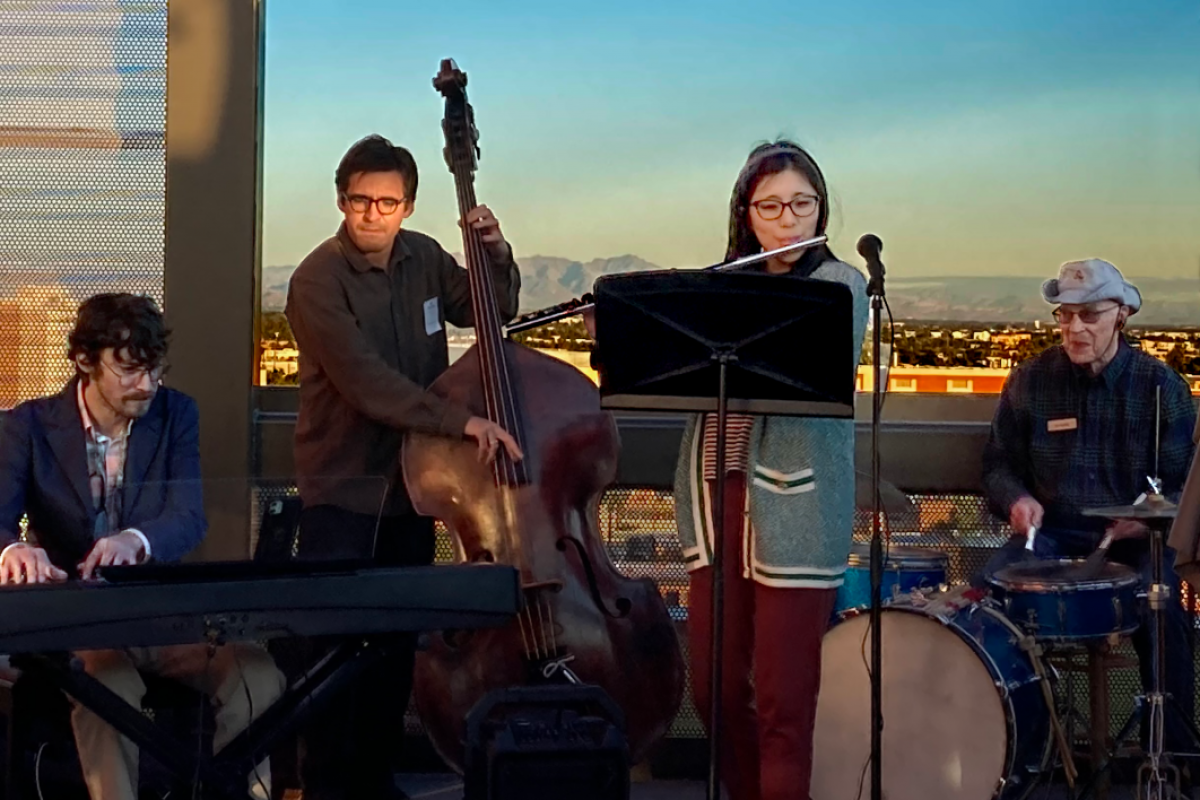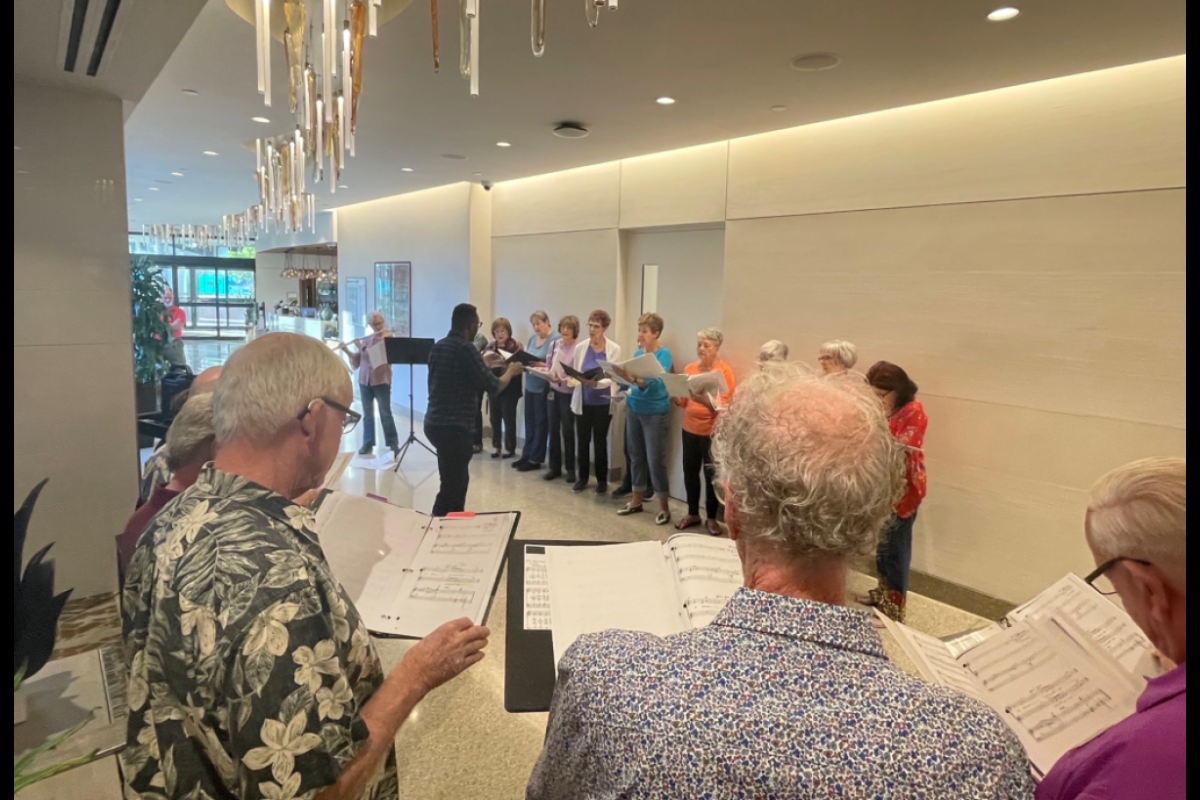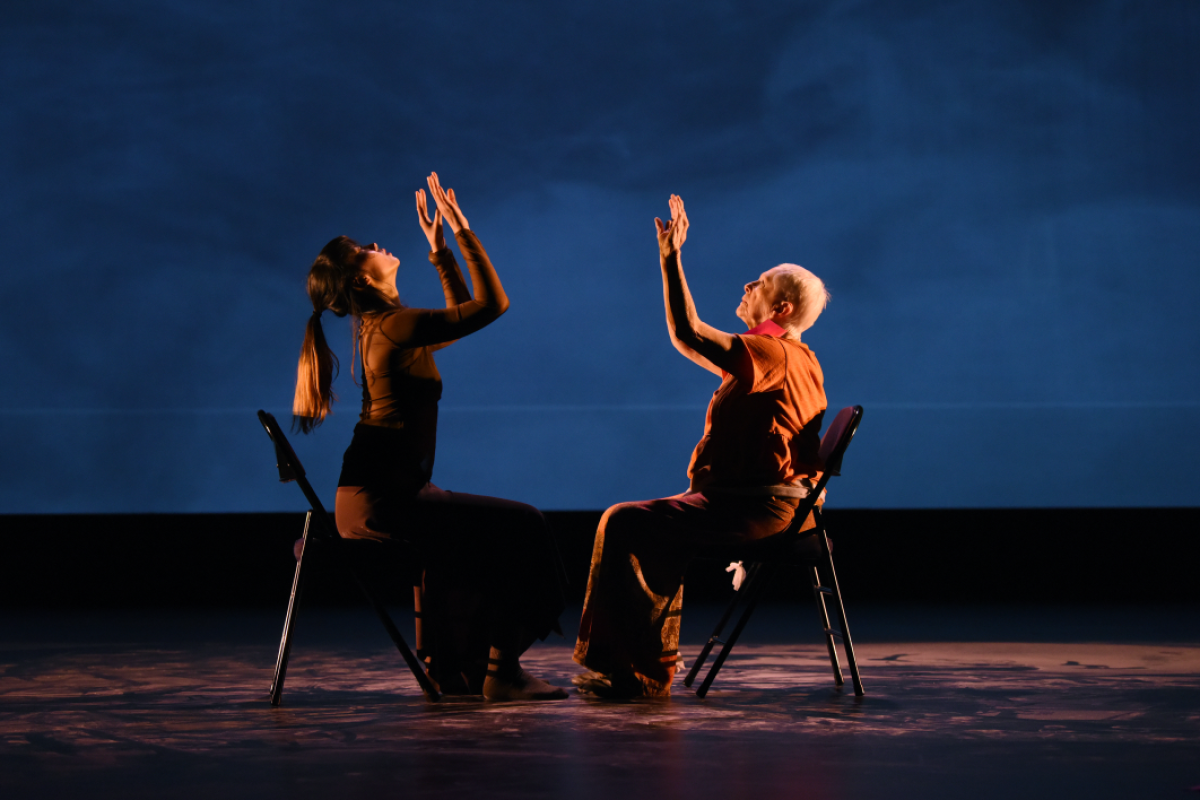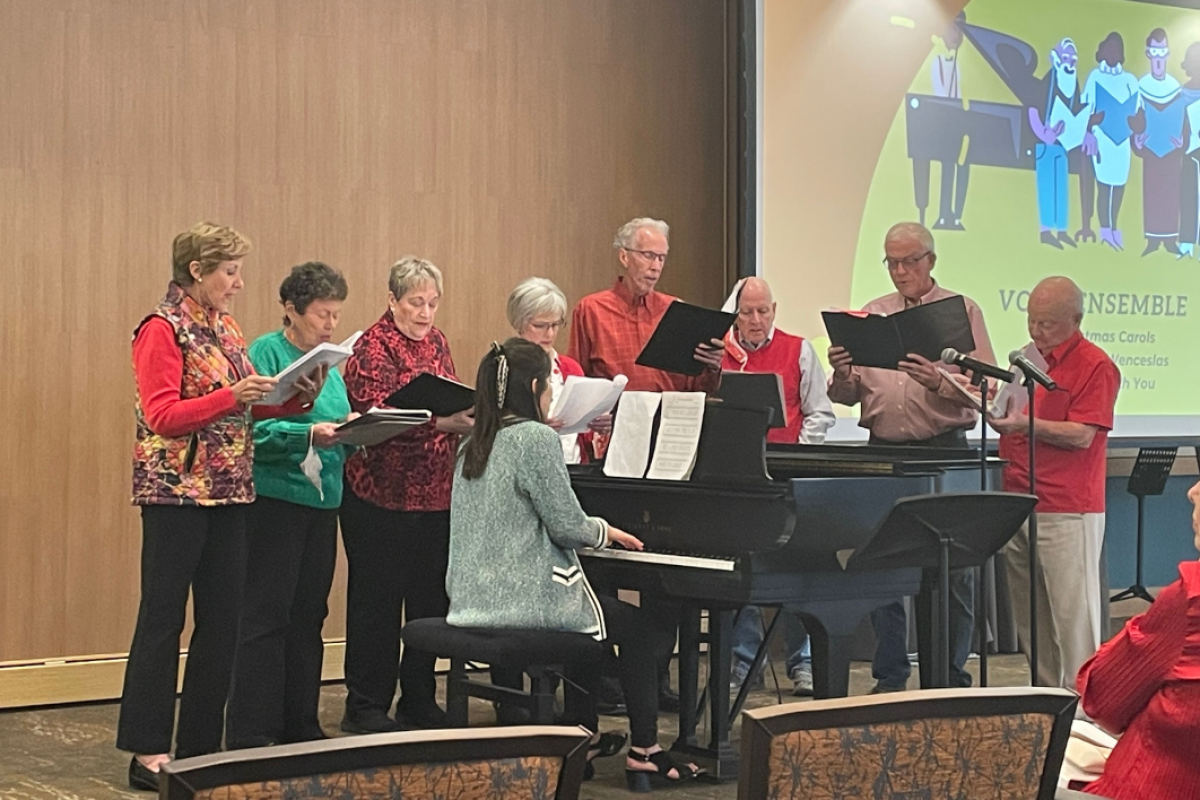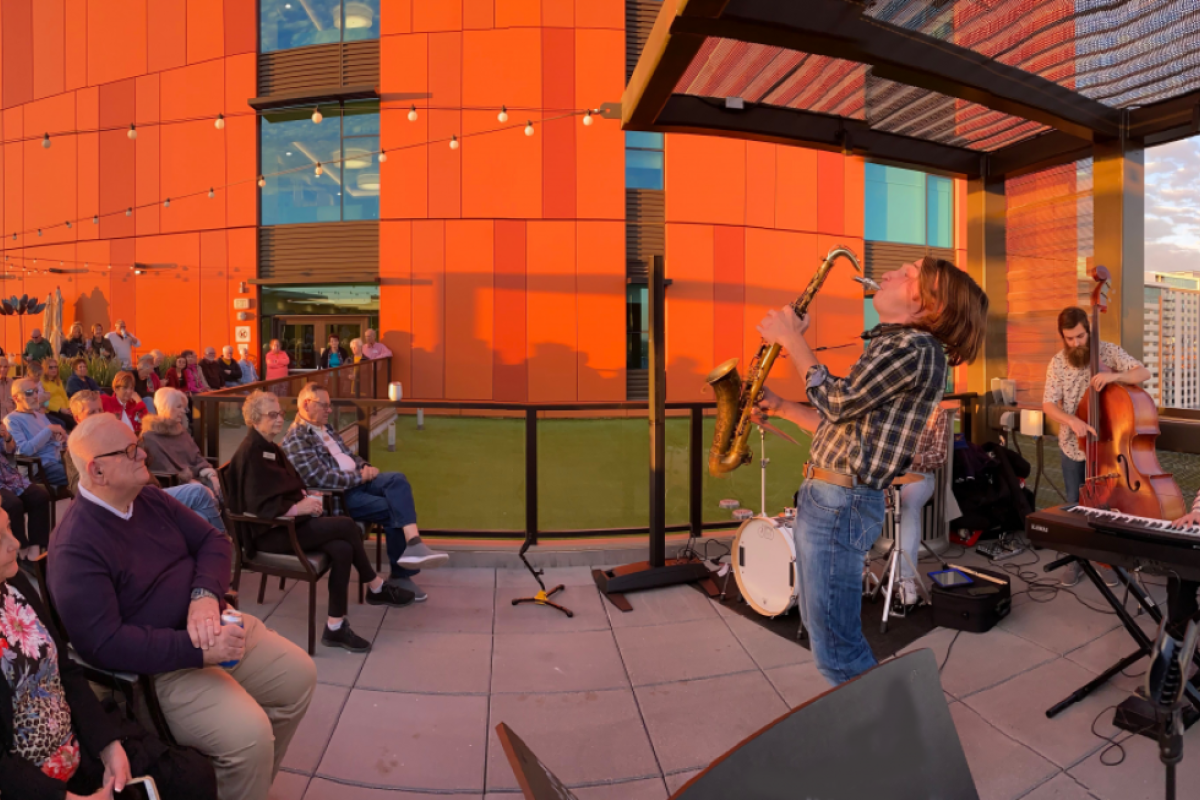Musicians-in-residence program at Mirabella at ASU wins top honors

Mirabella residents perform with ASU students in the musicians-in-residence program. Photo courtesy Mirabella at ASU
Mirabella at ASU, a university-based retirement community on the northwest corner of the Arizona State University Tempe campus, offers independent-living apartments, assisted living units, skilled nursing and memory care, and a unique program in which ASU students reside and engage with residents on reciprocal projects: the musicians-in-residence (MIR) program.
The Mirabella MIR program was named winner of the 2023 Innovation Award by Arizona LeadingAge at the nonprofit's annual conference on May 19.
The award recognizes an organization that creates an innovative program or service on their campus, such as technology advancement, environmental design or impact to residents and/or employees.
“The MIR program is a 10-month intergenerational, fully immersive and mutually beneficial program that connects generations based on a shared love of music and the arts,” said Lindsey Beagley, director of lifelong university engagement at ASU. “Because Mirabella is situated so close to campus, it is designed to not only bring music into the building, but also help residents explore and become familiar with the nearby arts and culture scene.”
Each year, four exceptional graduate students are selected to participate in MIR. The inaugural program launched in fall 2021 with music students; this August, the program — in response to a request from the Mirabella residents — will include a graduate dance student and will be renamed the artists-in-residence (AIR) program.
The program also engages residents with free or reduced-price access to more than 650 music, dance and theater events each year, including productions, ensemble concerts and recitals by guest artists, faculty and students as well as performances at ASU Gammage. Residents can also participate in several musical ensembles on campus, some of which do not require an audition.
Beagley said planning for the MIR program began in 2019 when she and C. Samuel Peña, assistant director of the popular music program, were asked to co-design the program by Heather Landes, director of the School of Music, Dance and Theatre.
In addition to bringing musical programming to the residents, who are 62 years and older, they wanted to provide an opportunity for the students to build relationships with the residents.
“We designed the program from the ground up,” said Peña, who was the school’s community engagement coordinator at the time. “This included merging the missions and goals of Mirabella and ASU.”
Peña’s academic research focuses on community and participatory music, so he researched music schools throughout the United States to discover if similar programs existed.
Creative aging
As a music facilitator and teaching artist in the field of creative aging, Peña is experienced with the social and mental benefits of interactive music experiences, especially with participants whose ages span generations.
A major design choice, Peña said, was to replace one of the two required weekly performances with a flex engagement to create mutually beneficial experiences for both the students and the residents. Flex engagements encourage the students and residents to get to know each other and discuss areas of interest.
“I wanted the residents to be inspired and feel seen and included in the decisions ... shaping their community,” Peña said. “I love watching them light up with inspiration during a performance and then again when they are participating in a flex engagement they took part in shaping.”
While the graduate students are selected in part because of their musical excellence, Peña said the flex engagement allows them to showcase and strengthen hidden talents as well as experiment and try new things.
“They are providing art for the community and creating art with the community,” Peña said.
Beagley said one of the inaugural resident musician’s dissertations focused on the MIR program, and the emerging theme from the narratives he collected revealed the program was a deciding factor for residents in their decision to move into the community.
“What we have seen happen over time is that fantastic intergenerational relationships are developing, not just over music, but as neighbors and community members,” Beagley said.
She said the program also encourages residents to get out of their comfort zones and explore something new that they might not have done on their own, which is key for an older adult living on a college campus.
“They are building a level of community with the actual campus,” said Beagley.
Beagley said bringing a movement and dance aspect to the program will reach people who have not necessarily felt connected to music.
“The people living in Mirabella have had incredible lives and very often they don't get an opportunity to talk to our students, who are also living incredible lives and have incredible skill sets,” Peña said. “The university is a very curious place, and when those two worlds converge together, it allows both of the parties to grow in ways that they could not otherwise.”
Da Hye "Michelle" Kim, pursuing a Doctor of Musical Arts in collaborative piano, has been the student coordinator with MIR since January 2022.
Kim said Mirabella’s idea of lifelong learning is applicable to any age. She took art classes together with residents, which reminded her how much fun she had going to art classes as a 5-year-old. She started playing the flute again, her secondary instrument, and even entered the Arizona Flute Festival and Competition with resident Emily Zeigler.
“The residents here are very talented and have so much to offer,” Kim said. “You share ideas and different perspectives with them and grow as a person.”
Kim said one of her favorite experiences was when the MIR students went to fine dining with the residents, and afterward they all went to the exercise room and played table tennis in their dinner clothes.
“As an artist and student, you get to bring all your dreams and see them come true here,” Kim said. “We are encouraged to experiment with even the silliest ideas and we get tons of support. We have huge supporters and loving fans. This is a once-in-a-lifetime experience.”
Beagley said the program is very innovative and creative and is a win-win for everybody.
“If you think about the definition of innovation — putting two things together that do not typically belong together and creating something new that is more than the sum of its parts — that is really this program in a nutshell,” Beagley said.
Peña, the school’s representative for the program, also attends the welcome orientation, meets with the artists-in-residence, facilitates the selection panel and call for applications, and reviews the applications.
“The project design, selection process, and excellent artistic and social skills of the AIRs will make this program successful for years to come,” Peña said.
The MIR program received an honorable mention during the 2022 Promising Practices Awards from the Mather Institute for developing and implementing innovative approaches that are reshaping the aging services industry. Mirabella at ASU received the 2022 Innovation Award for being a university-based retirement community concept.
More Arts, humanities and education
ASU FIDM students to see their designs on the runway at Uncertainty Fashion Showcase
Nola Hill is perfecting every stitch of her fashion design collection, which she started conceptualizing last summer.She is among…

ASU+GSV Summit brings experts together to discuss innovation in education
This week, Arizona State University President Michael Crow and other university leadership joined education and learning experts…

ASU professor's project helps students learn complex topics
One of Arizona State University’s top professors is using her signature research project to improve how college students learn…


